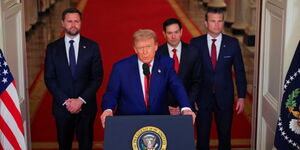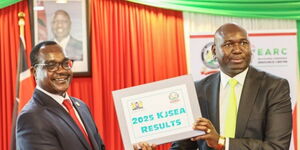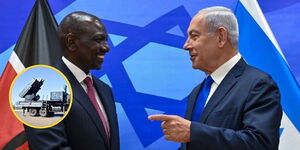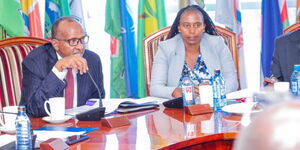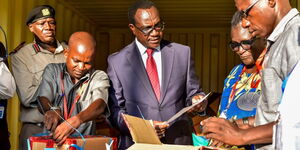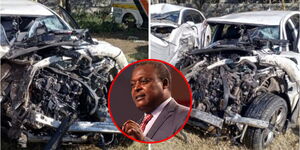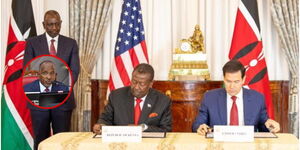Kenya's political temperatures were at an all-time high in 2017 - it being an election year.
This was the country's second election under the Constitution 2010 with many political giants such as former Governors Isaac Ruto and Evans Kidero falling while newbies on the scene rose (Kirinyaga Governor Anne Waiguru, Mohammed Ali and Embakasi East MP Babu Owino) to clinch their respective seats.
In a year of intrigues that spilled over to 2018, Kenya has had two presidential elections. After the nullification of the first by the Supreme Court, National Super Alliance (NASA) leader (Raila Odinga swore himself in as the people's president as his coalition set up people's assemblies in the country.
Through all this drama, the one thing that kept the political players and watchers on the edge of their seats were which documents/ memos would leak to tilt the stage in the other's favour.
[caption caption="Raila Odinga during his oath taking on Jaunary 30th"] [/caption]
[/caption]
Definitely, the past eight months have had nothing short of these political games. Here are some of the events in which leaked documents played a role in fullfilling.
They have been arranged chronologically from July 2017.
1. Government using KDF to Rig elections - NASA Claims
Weeks to the August 8 elections, NASA leaders threatened to boycott the August 8 elections claiming they had evidence that the Jubilee government was plotting to use the military to rig the poll.
In their possession was a confidential document detailing how Jubilee would use the military to create a state of anarchy in order to stay in power.
KDF confirmed that the document was genuine but denied claims of being used to rig the elections.
[caption caption="President Uhuru Kenyatta with KDF soldiers"] [/caption]
[/caption]
The damage was already done, however, as the documents created doubt on the credibility of the elections which would be nullified by the Supreme Court a month later.
2. Intrigues within the Supreme Court
As the Supreme Court case challenging President Uhuru Kenyatta's win was in progress, details emerged that insinuated that some of the judges had been compromised to rule in favour of NASA.
In two petitions which were filed 48 hours before the Supreme Court bench gave their ruling on the Presidential election, Derrick Malika Ngumu claimed that Deputy Chief Justice (DCJ) Philomena Mwilu and Justice Isaac Lenaola were in contact with lawyers representing the petitioner (Raila) during the hearing of the case.
Mr Ngumu who is the Executive Director of Angaza Empowerment Network, accused the DCJ of having had telephone conversations and meetings with Raila's lead counsel James Orengo, Senators Amos Wako and Moses Wetangula who were all directly linked to the case.
The explosive petitions were detailed with the time of calls, duration of the calls and locations of the calls in the period when the Supreme Court was handling the Presidential Petition case.
[caption caption="The Supreme Court during session"] [/caption]
[/caption]
Moreover, all the telephone conversations mentioned in the petition had supporting documents which appear to have been obtained from a telephone service provider because it also contained mast codes and ID numbers of people involved in the calls.
The Presidential petition was marred with further controversy as a voter identified as Rashid Mohammed, wrote a letter to EACC demanding that those who prepared the Court's report including Registrar of the Supreme Court Esther Nyaiyaki be investigated.
This came after Justice Njoki Ndung'u, in her dissenting ruling, claimed that some of the contested forms 34A and 34B were signed and had security features, contrary to the findings of the report.
3. Chebukati's Memo
After the Supreme Court nullified the August 8 presidential elections, embattled Independent Electoral and Boundaries Commission (IEBC) chairman Wafula Chebukati sent a memo marked as confidential to CEO Ezra Chiloba demanding tough answers.
In the leaked memo, the Chair demanded a number of explanations including why his (Chebukati) password was allegedly used to access the results transmission system.
He also wanted to know why the satellite phones bought by the commission were not used to relay data from polling stations among a myriad of things.
[caption caption="IEBC chairman Wafula Chebukati"] [/caption]
[/caption]
The memo put Chiloba in the crosshairs of the opposition coalition as they demanded his arrest and resignation after the August elections.
Furthermore, NASA got the ammunition they needed to prove that changes needed to be made at the electoral body if they were to participate in the fresh elections in October.
NASA leader Raila Odinga even called for President Uhuru’s resignation in light of the revelations made in the letter.
The opposition coalition made true to their threat as they boycotted the fresh October elections, handing Uhuru a landslide victory.
4. Government Withdrawing Raila's Security
The call for withdrawing from the election by the opposition coalition set off a chain reaction that saw the government crackdown on NASA leaders.
The opposition called for protests dubbed anti-IEBC demos to have the team (led by CEO Chiloba) kicked out.
On the eve of the planned demos, Odinga and Wiper leader Kalonzo Musyoka had their security withdrawn.
Interior CS Fred Matiang’i stated that the move to recall police officers assigned to the two opposition leaders would not be reversed.
[caption caption="Raila addressing the media"] [/caption]
[/caption]
A leaked document later that month showed that Deputy Inspector-General in charge of the Kenya Police, Joel Kitili, was the one behind the recalling bodyguards assigned to the NASA Principals.
The withdrawal of the security detail was prompted by "severe personnel constraints currently facing the service arising from growing demand to respond to a number of security challenges."
The leaked document, dated September 25, also instructed the commanders to recall officers assigned to guard former Deputy Prime Minister Musalia Mudavadi.
This resulted in the opposition leaders hiring private security while accusing the government of ill motives while proceeding with countrywide anti- IEBC demonstrations.
5. Akombe's Departure
On October 18th, Former IEBC commissioner Roselyn Akombe resigned days to the fresh Presidential election that had been ordered by the Supreme Court,
As uncertainty loomed over how the electoral body would conduct the election, Roselyne Akombe revealed that she had been threatened by one of the IEBC commissioners.
In a leaked memo addressed to IEBC Chairman Wafula Chebukati titled Planning for the Fresh Presidential Election, Ms Akombe stated that she was threatened with violence for giving dissenting opinions.
[caption caption=" Former IEBC commissioner Roselyn Akombe"] [/caption]
[/caption]
"Intimidation continues to the board, with even one commissioner threatening to go physically against me during an 18th September plenary meeting, could one still talk of a conducive environment for free, fair and credible elections," the memo read in part.
Eventually, the fresh election was held and Akombe after fleeing to the US was promoted to a senior position at the United Nations (UN).
6. Sonko and Igathe Split
Former Nairobi Deputy Governor Polycarp Igathe resigned in January over what he termed as failure to earn the trust of Nairobi Governor Mike Sonko.
Prior to his resignation, there were rumours that the Jubilee duo was heading to an impending split, claims they vehemently denied.
Governor Sonko even took to social media, uploading screenshots of their conversations to paint a picture of things working well.
“Looking at the attached texts and WhatsApp conversations does it look like we are falling apart?” He posted.
Days after calling it quits, a leaked audio emerged online of the last orders Igathe received from his boss.
[caption caption="Mike Sonko and Polycarp Igathe"] [/caption]
[/caption]
Sonko on his part told reporters that Igathe's resignation was a non-issue and that he would work without with his deputy.
7. Raila's swearing in
After NASA leader Raila Odinga announced that he would be sworn in as the people's president, Jubilee party held a meeting to discuss how they would handle the matter.
In December, KTN reported that a leaked memo from Jubilee strategists who attended the meeting in December had resolved to downplay Odinga's swearing-in and instead make a mockery of it.
This was supposedly because Jubilee strategists believed that NASA had been setting the agenda, and making it appear that the former Premier and President Uhuru Kenyatta were equals.
Jubilee's social media team had even been marshaled to create content poking fun at the event: "Social media should design a graphic to poke fun at Raila swearing-in.”
The memo read in part: “There are many presidents of many associations in Kenya – including the children’s parliament, Team Mafisi, boy child, etc. There is nothing wrong with Raila swearing himself as President of an association.
Just like the memo recommended, during the NASA leader's swearing-in on January 30th, the government withdrew officers from Uhuru park and let the opposition have their day as opposed to the force they use during Raila's homecoming.
8. Media Shutdown
The same was, however, not the situation for the media, whom the government cracked down with full force.
A day before NASA's event at Uhuru Park, Nation Media Managing director Linus Kaikai leaked that media owners had been summoned to State House and ordered not to air the swearing-in ceremony live at the risk of being shut down.
He sent out a statement as the Editors Guild Chairman arguing that the order was an infringement of media rights and vowed to carry out his duties without fear, a move that created divisions among the editors.
[caption caption="Linus Kaikai, Larry Madowo and Ken Mijungu"] [/caption]
[/caption]
The media bore the brunt of airing Odinga's swearing-in at Uhuru park as they had their TV stations switched off.
Citizen TV, NTV, KTN News and Inooro Tv had their signals switched off for days for disobeying the government's order.

